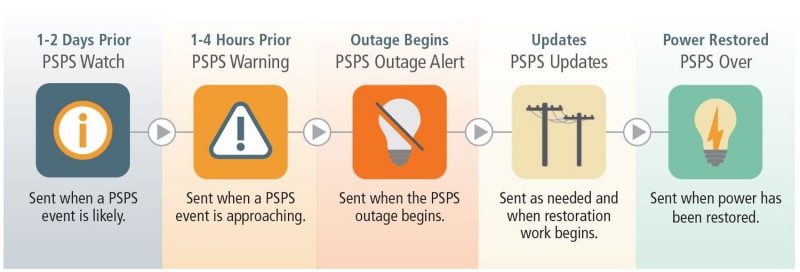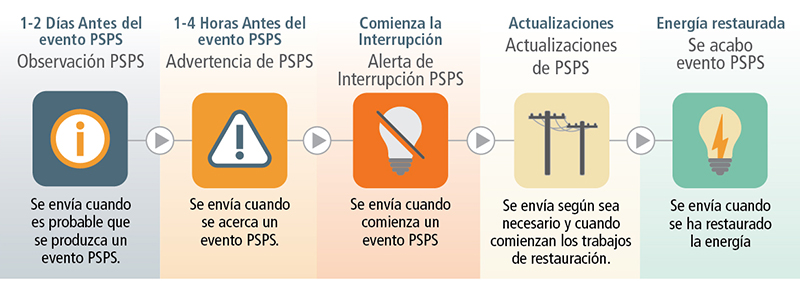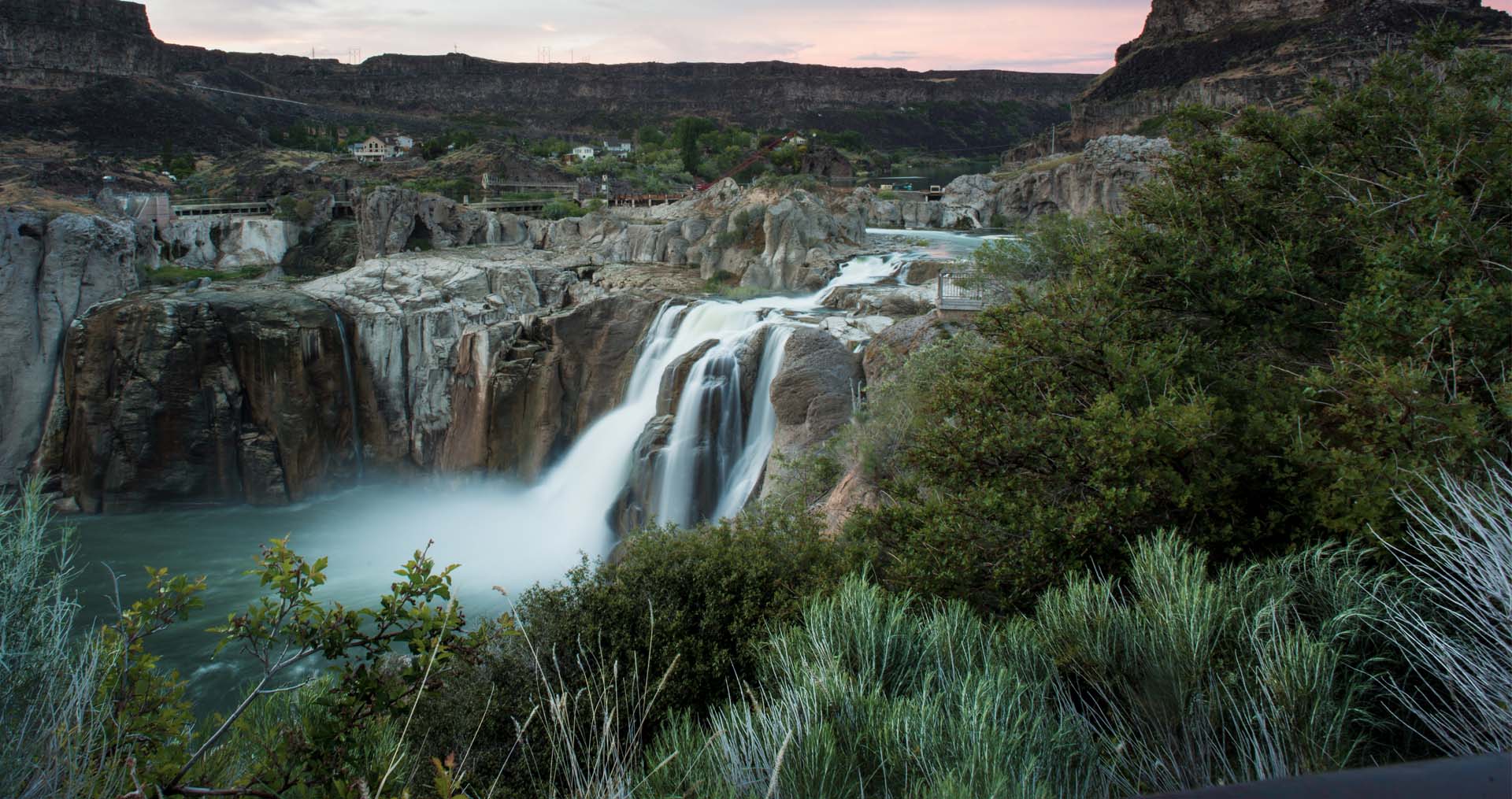A public safety power shutoff, or PSPS, is when a company like Idaho Power proactively turns off power to an area where wildfire risk is high due to extreme weather conditions. The outage is an effort to keep our communities safe.
A PSPS is a last resort to prevent wildfires. From trimming trees to wrapping poles in fire-resistant mesh to maintaining and inspecting our equipment, wildfire mitigation is part of year-round, everyday operations at Idaho Power.
Where are PSPS events most likely?
All customers should be prepared for outages, including a PSPS. Customers living near wildfire risk zones are more likely to experience a PSPS than others. Idaho Power has identified geographic zones with higher wildfire risk due to factors like vegetation, weather patterns, fire history, and structure density. For example, intense fires are more likely in forested areas than places with only low-growing vegetation like grasses.
In higher risk zones, we have changed operations to reduce the risk of wildfire during the fire season. These zones receive intensive inspection and vegetation management and are subject to special equipment and operational practices to reduce the risk of wildfire.
Any active PSPS events will display on the map below.
When is a PSPS used?
PSPS events are used only during extreme weather conditions — primarily high winds and dry vegetation — that lead to high fire risk. Many factors go into the decision to call a PSPS. Using forecasts and real-time observations, the following are the primary factors we look at in determining if a PSPS is necessary:

How will customers be notified?
Idaho Power is committed to providing as much advance notice as reasonably possible to help you prepare for a PSPS event. The company’s atmospheric scientists use weather stations to monitor fire conditions throughout our service area. These observations can help us inform customers of potential PSPS conditions.
Due to the size of Idaho Power’s service area, geographic and environmental diversity, and the unpredictable nature of the region’s weather, it can be hard to predict the need for a PSPS with much advance warning. As much as we can, we’ll keep you informed throughout an event using text messages, phone calls, and email. You can also look for updates on our website.
Make sure to update your contact information so we can reach you in an emergency.

Frequently Asked Questions
Stay informed. Know how to get the latest updates when an outage happens.
- Update your contact information if needed.
Make a plan. Whether you have special medical needs or livestock to water, make sure you’re ready to meet your unique needs, and those of your loved ones, during a long outage.
- Prepare for medical needs like refrigerated medicine or electrically powered medical equipment.
- Build a summer outage kit.
- Find a way to feed and water pets or livestock in case well pumps don’t have power.
Stay safe if the power goes out. If the lights do go out, know how to stay safe and minimize the impact of the outage.
- To protect your appliances, machinery, and equipment, turn off any that were in use when the power went out. Make sure to turn off electric ranges to prevent a fire if you’re away when power is restored. Keep one light on so you know when power has been restored.
- After power has been restored for about 10 minutes, begin turning back on appliances and lighting in 10-minute phases. This keeps circuits from overloading and helps to more quickly and safely restore everyone’s power.
- If you notice a downed power line, stay at least 100 feet back and report it to Idaho Power by calling 1-800-488-6151.
Learn more about how to prepare for summer outages.
- Prepare now for medical needs like refrigerated medicine or electrically powered medical equipment. This could mean finding a place you can go during an outage or using a backup generator.
- Call 211 for community resources during an emergency.
- For medical emergencies, call 911.
If you already have a My Account profile, you can easily update or confirm your contact information. Don’t have My Account yet? Visit our registration page to set up an online profile. We’ll walk you through a few easy steps to get you started.
You can also update your contact information in the space provided on the bottom of your bill before you send it in or call us at 1-800-488-6151.
Here are ways you can help protect our communities from wildfire:
- Monitor and obey fire restrictions.
- Use designated fire rings provided at campgrounds.
- Fully extinguish your campfire after use.
- Follow all firework laws and keep a hose nearby when lighting fireworks.
- Consider using glow sticks instead of sparklers.
- Never park or start a vehicle on dry grass.
- Keep trailer chains from dragging along roads.
- Check trailer tires for proper air pressure and ensure the rubber is in good condition.
- Never throw cigarettes from vehicles.
- Obtain appropriate fire permits (depending on type and location of fire).
- Create a defensible space around your home.
- Have a power outage kit ready.
Idaho Power is investing in grid improvements to protect the grid from wildfires and reduce the chance of starting fires. We’re also:
- Upgrading poles, conductors, and switches.
- Increasing equipment inspections by ground and air.
- Wrapping wood poles with fire-resistant mesh.
- Adding spark-prevention equipment to power lines in highest-risk areas.
- Monitoring and clearing vegetation around power lines.
- Treating ground around wood poles to keep vegetation from becoming fuel for fires.
- Conducting daily weather forecasts during wildfire season to monitor fire risk and change our operations if necessary.
- Burying strategically chosen sections of overhead lines.
- Using infrared imaging and other technologies to monitor equipment for defects.
Our Wildfire Mitigation Plan assesses wildfire risk in every corner of our service area to make sure we’re operating in a safe, responsible manner.
A PSPS is the last resort in wildfire prevention, but should one be necessary, it is guided by the following goals:
- Safety: protecting employees, customers, and the general public
- Collaboration: working with customers and public safety partners
- Minimizing risk: working to reduce the risk of wildfire but also the impacts of extended power outages
- Reliability: protecting people and equipment to restore reliable service to our customers and communities
Sometimes, Idaho Power shuts off certain power lines when a fire is burning toward them. We do this to keep the fire from damaging the lines and to protect firefighters, company employees, and the public.
A PSPS is different because Idaho Power would shut off power to certain lines before a fire started to reduce the risk of ignition in extreme conditions.
Idaho Power has identified zones across our service area with elevated wildfire risk. For details, visit our Protecting the Grid page. We have changed operations in these zones to reduce the risk of wildfire during the fire season. These zones receive intensive inspection and vegetation management and are subject to special equipment and operational practices to reduce the risk of wildfire. All customers should be prepared for outages, including the possibility of a PSPS. Customers living in or near wildfire risk zones are more likely than others to experience a PSPS.
A PSPS would last as long as the weather conditions that prompted it, plus any time needed to patrol the lines before safely re-energizing it. After the weather has passed, patrolling lines ensures that no damage, such as falling trees, has occurred. Once those problems were resolved and Idaho Power determined it was safe, the company would re-energize the line. This process could last several hours or even days. If storm damage occurs, restoration could take longer.
¿Qué es un corte de suministro eléctrico por razones de seguridad pública?
Un corte de suministro eléctrico por razones de seguridad pública, o PSPS por sus siglas en inglés, ocurre cuando una empresa como Idaho Power apaga de forma proactiva la energía en un área donde el riesgo de incendios forestales es alto debido a condiciones climáticas extremas. El apagón es un esfuerzo para mantener seguras a nuestras comunidades.
Un corte PSPS es un último recurso de prevención contra incendios forestales. Idaho Power nunca ha llamado a un corte PSPS, aunque la compañía a veces ha cortado la energía a algunas líneas eléctricas para proteger a los bomberos en el área. En Idaho Power, la mitigación de incendios forestales forma parte de las operaciones cotidianas a lo largo del año, que van desde la poda de árboles y envolver postes con malla especial contra incendios, a dar mantenimiento e inspeccionar nuestros equipos.
Zonas con mayor probabilidad de cortes PSPS
Idaho Power identifica las zonas con mayor riesgo de incendios forestales, y modifica sus operaciones en la zona a fin de reducir el riesgo de incendios forestales durante la temporada de los mismos.
Estas zonas están sujetas a una inspección estricta y un control de la vegetación, así como al uso de equipos y aplicación de prácticas de operación especiales para reducir el riesgo de incendios forestales.
Idaho Power está actualizando las zonas PSPS para la temporada de incendios forestales de 2024. Se mostrarán en el mapa que se presenta abajo cuando estén disponibles.
![]() = Zona activa de PSPS
= Zona activa de PSPS
¿Cuándo se utiliza un PSPS?
Los cortes PSPS solo se utilizan en condiciones climáticas extremas, sobre todo vientos fuertes y vegetación seca, que son causa de un alto riesgo de incendio. Son muchos los factores que intervienen en la decisión de realizar cortes PSPS. Los siguientes son los principales factores que, junto con el uso de pronósticos del tiempo y observaciones en tiempo real, se consideran para determinar la necesidad de cortes PSPS:

¿Cómo notificamos a los clientes?
El compromiso de Idaho Power es notificar con la suficiente anticipación posible para permitir que sus clientes se preparen para un corte PSPS.
Debido a la extensa área de servicio de Idaho Power, a la diversidad geográfica y medioambiental, y al clima impredecible de la región, puede ser difícil pronosticar con mucha anticipación la necesidad de un corte PSPS. Sin embargo, los mantendremos lo más informados posible durante un corte ya sea a través de mensajes de texto, llamadas telefónicas o por correo electrónico. También podrá buscar las actualizaciones en nuestro sitio web.
Asegúrese de actualizar su información de contacto para que podamos localizarlo en caso de emergencia.

Preguntas frecuentes
- Actualice su información de contacto.
Haga un plan. Si tiene necesidades médicas especiales o piensa cómo darle de beber al ganado, asegúrese de estar preparado para sus propias necesidades y las de sus seres queridos durante una interrupción prolongada del servicio eléctrico.
- Prepárese para necesidades médicas, por ejemplo, medicamentos que requieran refrigeración o equipo médico eléctrico.
- Prepare un kit de apagones de verano.
- Piense en cómo les va a dar de comer y de beber a las mascotas o al ganado si las bombas del pozo de agua no funcionan sin electricidad.
Manténgase a salvo si se produce una interrupción del servicio. De haber un apagón, manténgase a salvo para minimizar el impacto de la interrupción del servicio.
- Apague los aparatos electrodomésticos, maquinaria y equipos que estaban en uso durante el corte de energía para protegerlos. Asegúrese de apagar las hornillas eléctricas para evitar la posibilidad de un incendio en caso de que se restablezca el suministro eléctrico mientras usted no está en casa. Mantenga una luz encendida para que sepa en qué momento se restablece el servicio.
- Una vez que se restablezca el servicio de energía, espere 10 minutos antes de encender de nuevo los aparatos y luces en etapas de 10 minutos. Con ello evita la sobrecarga de los circuitos y ayuda a que el servicio de todos regrese con mayor rapidez y de forma segura.
- Si ve una línea derribada, manténgase a una distancia de al menos 100 pies y comuníquese de inmediato con Idaho Power al 1-800-488-6151.
Más información acerca de cómo prepararse para los apagones de verano.
- Prepárese para necesidades médicas, por ejemplo, medicamentos que requieran refrigeración o equipo médico eléctrico. Tal vez tenga que irse a otro lugar durante una interrupción del servicio o comprar un generador adicional.
- Llame al 911 para mantenerse en contacto con los recursos en la comunidad durante una emergencia.
- En el caso de emergencias médicas, llame al 911.
Si ya tiene un perfil en «My Account», puede actualizar o confirmar su información de contacto. ¿No se ha inscrito aún en «My Account»? Visite nuestra página de registro y configure un perfil en línea. Le mostraremos algunos pasos sencillos para comenzar el proceso.
También puede actualizar su información de contacto en el espacio que aparece en la parte inferior de su factura antes de enviarla o puede llamarnos al 1-800-488-6151.
Las siguientes son algunas formas de ayudar a proteger nuestras comunidades contra incendios forestales:
- Monitorear y cumplir con las restricciones en caso de incendio.
- Utilizar los círculos de fuego designados en las áreas de campamento.
- Apagar completamente la fogata después de utilizarla.
- Respetar las leyes respecto a los fuegos artificiales y conservar una manguera cerca cuando se enciendan los fuegos artificiales.
- Considerar el uso de barras luminosas en lugar de luces de bengala.
- No estacionar ni poner en marcha un auto sobre hierba seca.
- Evitar que las cadenas para remolque arrastren sobre el pavimento.
- Revisar que la presión de aire de los neumáticos sea el adecuado y que las gomas estén en buenas condiciones.
- No arrojar cigarrillos encendidos desde un vehículo.
- Obtener los permisos para fogatas correspondientes (dependiendo del tipo y el lugar donde se encuentre la fogata).
- Crear una línea de protección contra incendios alrededor de su casa.
- Preparar un kit para las interrupciones de energía eléctrica.
Idaho Power invierte en mejoras que permiten proteger la red de suministro eléctrico contra incendios forestales y reducir el riesgo de incendios. Asimismo:
- • Invertimos en mejoras de postes, conductores e interruptores.
- Aumentamos las inspecciones de equipos en tierra y aire.
- Envolvemos los postes de madera con una malla especial contra incendios.
- Agregamos equipos de prevención de chispas a las líneas eléctricas en las áreas de mayor riesgo.
- Monitoreamos y despejamos la vegetación alrededor de las líneas eléctricas.
- Damos mantenimiento al suelo y despejamos alrededor de los postes de madera para evitar que la vegetación se convierta en «combustible» de incendios.
- Realizamos pronósticos del tiempo diariamente durante la temporada de incendios forestales para controlar el riesgo de incendios y, de ser necesario, hacer cambios acordes a nuestras operaciones.
En nuestro Plan de mitigación de incendios forestales se evalúa el riesgo de incendios forestales en cada rincón de nuestra área de servicio para asegurarnos de que nuestras operaciones son seguras y responsables.
Un corte PSPS es el último recurso en la prevención de incendios forestales, aunque en caso de ser necesario, se guía por los siguientes objetivos:
- Seguridad: proteger a los empleados, clientes y público en general
- Colaboración: trabajar en conjunto con los clientes y los integrantes de la seguridad pública
- Reducción de riesgos: reducir el riesgo de incendios forestales y el impacto de la interrupción prolongada de la energía
- Confiabilidad: proteger a la gente y los equipos para restablecer un servicio confiable a nuestros clientes y comunidades
A veces, Idaho Power corta ciertas líneas eléctricas después de que ha comenzado un incendio. Esto es para proteger a los bomberos, empleados de la compañía y otras personas en el área.
Un PSPS es diferente porque tendría lugar antes de que comenzara un incendio, para reducir el riesgo de ignición debido a que un árbol toque una línea eléctrica o algún otro percance.
En Idaho Power identificamos las zonas con mayor riesgo de incendios forestales en nuestra área de servicio. Visite nuestra Página de cómo proteger la red eléctrica, donde encontrará más detalles. En estas áreas cambiamos nuestras operaciones para reducir el riesgo de incendios forestales durante la temporada. A fin de reducir el riesgo de incendios forestales, estas áreas están sujetas a una inspección rigorosa, manejo de la vegetación, equipos y operaciones especiales.
El riesgo de incendios forestales es sumamente alto en varias zonas geográficas pequeñas debido a factores como la vegetación, patrones climáticos, antecedentes de incendios y densidad de estructuras. Por ejemplo, la probabilidad de incendios intensos es mayor en áreas forestales que en sitios con vegetación de bajo crecimiento, como pasto. Un área boscosa donde hay muchas casas y otras estructuras podría tener un mayor riesgo de sufrir daños por incendios destructivos y costosos.
Un corte PSPS duraría tanto como lo provoquen las condiciones climáticas. En cuanto el clima es lo bastante templado como para volver a reactivar la electricidad, Idaho Power patrulla las líneas desenergizadas para tener la seguridad de que no hubo daños, como árboles caídos. Una vez resueltos dichos problemas y que Idaho Power determine que está seguro el área, la compañía reenergiza la línea. Este proceso podría durar varias horas, incluso días.
For assistance with a PDF on this page or to request a PDF in an alternate format, please contact Customer Service at 208-388-2323 or 1-800-488-6151
